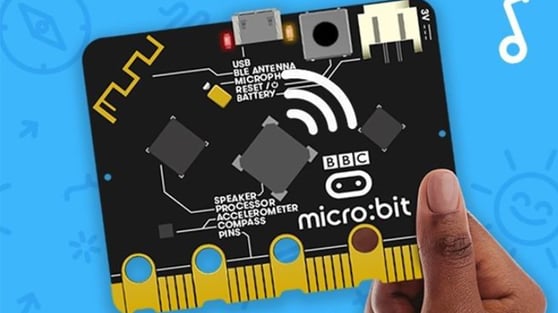Back to articles
New micro:bit V2 offers much more to tomorrow’s innovators

As children grow up in an increasingly connected world, it’s essential they understand not only the potential but also the inherent risks of emerging connected technologies. By getting hands-on with wireless educational devices like the Nordic-powered next generation ‘micro:bit V2’, the innovators of tomorrow can learn those lessons today.
Major micro:bit update
The micro:bit V2, a pocket-sized educational computer, recently received its first important update since the 2016 launch of the original Nordic nRF51822 SoC-powered model. Designed to be completely familiar to users of the first version and fully compatible with existing code, the latest model of the micro:bit has been impressively upgraded after consultation with teachers and the global micro: bit community.
According to Gareth Stockdale, CEO of the micro:bit Educational Foundation and a joint lead on the original BBC project, the micro:bit V2 will be even better at helping children unlock their creative potential and learn how to shape the world around them. Stockdale believes that learning coding and computational thinking can enhance children’s life and career opportunities in the 21st century.
Global impact
The British Broadcasting Corporation (BBC) micro:bit initiative was launched in the U.K. in 2016 by giving free devices to every seventh-year student. It was a part of the corporation’s “Make it Digital," an unprecedented and highly ambitious project. Today it's being used in most U.K. secondary schools to teach 11 to 14-year-olds. But it's also hugely popular with primary school teachers tutoring 8 to 11-year-olds.
The micro:bit Educational Foundation has donated approximately 30,000 micro:bit devices to institutions, including schools, libraries, and NGOs, through various schemes. The foundation has also offered up to 5,000 micro:bits to families in the U.K. wanting to continue learning at home during the ongoing COVID-19 pandemic. And the micro:bit is being used in projects across Africa, Asia, Australasia, the Americas, and Europe. Overall, some five million micro:bits have helped more than 25 million children in over 60 countries understand digital creativity and computing skills.
According to Geir Langeland, Director of Sales and Marketing, Nordic Semiconductor, they have participated enthusiastically in the micro:bit project from the start. Nordic supports this educational computer to encourage and train the engineers who will build tomorrow’s connected world.
Endless creativity
The micro:bit V2’s hardware includes several technical upgrades to help the device become a transformative tool for exploring, understanding, and experimenting with artificial intelligence (AI) and machine learning (ML) in the classroom.
Join Nordic's webinar, Introduction to the new micro:bit V2
Exciting AI and ML possibilities are now available to micro:bit V2 users through applications that respond to advanced patterns of sound, voice, motion, or light. This is because the micro:bit V2 now includes a built-in speaker and MEMS microphone that support teaching with sound straight out-of-the-box. The dedicated ‘microphone operating’ LED makes it clear when the microphone is on and sensing sound, allowing teachers to engage with students about privacy issues and the impact of listening devices.
Making the most of the micro:bit V2s new microphone, early experiments with Edge Impulse (a development platform for machine learning on edge devices) created a voice-activated micro:bit by training the device to recognize custom keywords. Elsewhere, work with Espruino (an open-source JavaScript interpreter for microcontrollers) and Tensorflow Lite (an open-source deep learning framework for on-device inference) involved training an ML model for micro:bit V2s to recognize gestures. This could mean using the micro:bit V2 to control projects by flicking a wrist, tilting a hand, or jumping up and down.
The built-in speaker also helps users compose music, give projects a voice and personality, or build interactive, motion-sensitive instruments. In turn, the microphone allows the device to respond to sound – useful for applications such as making a disco light that dances along in time with the music.
Nordic-enabled functionality
The new BBC micro:bit uses a Nordic nRF52833 SoC as the device’s main microprocessor. It supports new complex functionality such as AI and ML applications. The SoC's powerful 64MHz, 32-bit Arm Cortex M4 processor with a floating-point unit (FPU) is a significant upgrade on the 16MHz, 32-bit Arm Cortex M0 processor used on the original micro:bit. The nRF52833 has 512kB of Flash memory (double what is available on the original micro:bit) and 128kB of RAM (eight times that of the original device). The nRF52833 also supports full-speed (12 Mbps) USB.
The nRF52833 has been engineered to minimize power consumption, providing the new micro:bit with extended battery life. It enables long-running data logging, for example, and a power-off mode that conserves power when the device is powered via battery or not being used.
The Nordic SoC offers Bluetooth Low Energy (Bluetooth 5.2) wireless connectivity. It is interoperable with other micro:bits, smartphones or tablets, or any other Bluetooth LE device, opening up exciting connected digital education possibilities.


